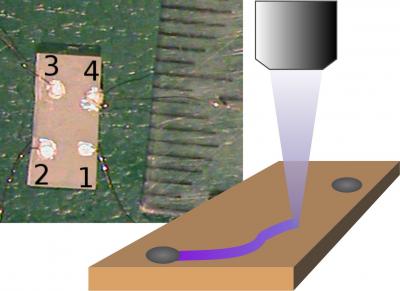WSU physicists turn a crystal into an electrical circuit

Washington State University researchers used light to write a highly conducting electric path in a crystal. This opens up the possibility of transparent, three-dimensional electronics that, like an Etch-A-Sketch, can be erased and reconfigured. On the left, a photograph of a sample with four metal contacts. On the right, an illustration of a laser drawing a conductive path between two contacts. Credit: Washington State University
Washington State University physicists have found a way to write an electrical circuit into a crystal, opening up the possibility of transparent, three-dimensional electronics that, like an Etch A Sketch, can be erased and reconfigured.
The work, to appear in the on-line journal Scientific Reports, serves as a proof of concept for a phenomenon that WSU researchers first discovered by accident four years ago. At the time, a doctoral student found a 400-fold increase in the electrical conductivity of a crystal simply by leaving it exposed to light.
Matt McCluskey, a WSU professor of physics and materials science, has now used a laser to etch a line in the crystal. With electrical contacts at each end of the line, it carried a current.
“It opens up a new type of electronics where you can define a circuit optically and then erase it and define a new one,” said McCluskey. “It's exciting that it's reconfigurable. It's also transparent. There are certain applications where it would be neat to have a circuit that is on a window or something like that, where it actually is invisible electronics.”
Ordinarily, a crystal does not conduct electricity. But when the crystal strontium titanate is heated under the right conductions, it is altered so light will make it conductive. The phenomenon, called “persistent photoconductivity,” also occurs at room temperature, an improvement over materials that require cooling with liquid nitrogen.
“We're still trying to figure out exactly what happens,” said McCluskey. He surmises that heat forces strontium atoms to leave the material, creating light-sensitive defects responsible for the persistent photoconductivity.
McCluskey's recent work increased the crystal's conductivity 1,000-fold. The phenomenon can last up to a year.
“We look at samples that we exposed to light a year ago and they're still conducting,” said McCluskey. “It may not retain 100 percent of its conductivity, but it's pretty big.”
Moreover, the circuit can be by erased by heating it on a hot plate and recast with an optical pen.
“It's an Etch A Sketch,” said McCluskey. “We've done it a few cycles. Another engineering challenge would be to do that thousands of times.”
The research was funded by the National Science Foundation. Co-authors on the paper are former students Violet Poole and Slade Jokela.
The work is in keeping with WSU's Grand Challenges, a suite of initiatives aimed at addressing large societal problems. It is particularly relevant to the challenge of Smart Systems and its theme of foundational and emergent materials.
Media Contact
All latest news from the category: Physics and Astronomy
This area deals with the fundamental laws and building blocks of nature and how they interact, the properties and the behavior of matter, and research into space and time and their structures.
innovations-report provides in-depth reports and articles on subjects such as astrophysics, laser technologies, nuclear, quantum, particle and solid-state physics, nanotechnologies, planetary research and findings (Mars, Venus) and developments related to the Hubble Telescope.
Newest articles

Superradiant atoms could push the boundaries of how precisely time can be measured
Superradiant atoms can help us measure time more precisely than ever. In a new study, researchers from the University of Copenhagen present a new method for measuring the time interval,…

Ion thermoelectric conversion devices for near room temperature
The electrode sheet of the thermoelectric device consists of ionic hydrogel, which is sandwiched between the electrodes to form, and the Prussian blue on the electrode undergoes a redox reaction…

Zap Energy achieves 37-million-degree temperatures in a compact device
New publication reports record electron temperatures for a small-scale, sheared-flow-stabilized Z-pinch fusion device. In the nine decades since humans first produced fusion reactions, only a few fusion technologies have demonstrated…





















